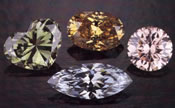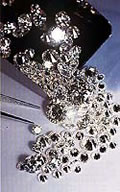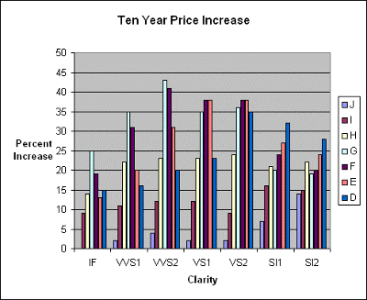 Many people think of diamonds as an investment. In recent years they have increased in value but there are numerous reasons why we do not think diamonds should be considered for investment purposes.
Many people think of diamonds as an investment. In recent years they have increased in value but there are numerous reasons why we do not think diamonds should be considered for investment purposes.
1) While De Beers does, to a great extent, control the distribution and pricing of rough (uncut) diamonds, they do not control the price of polished diamonds. Polished diamond prices fluctuate up and down and are highly impacted by things such as interest rates and inflation. During the high inflation period of 1978-1980 in the U.S., white diamonds were approximately 4 times more expensive than they were twenty years later.
Click here for our discussion of diamond prices
 2) Top quality diamonds are more liquid than real estate but less liquid than stocks or gold. It will take some time to find a buyer for your “investment” diamond. Expect the wholesale or retail buyers to offer you much less than they are selling the same diamonds for.
2) Top quality diamonds are more liquid than real estate but less liquid than stocks or gold. It will take some time to find a buyer for your “investment” diamond. Expect the wholesale or retail buyers to offer you much less than they are selling the same diamonds for.
3) Like any good investment, the purchase price is just as important as the selling price. Do not expect to buy a diamond at a jewelry store with 100% mark up and then expect to make money selling it in a couple of years. If you do not have a retail source that is able to sell you at 5 to 10% over their cost, you are paying too much.
 4) The diamonds that have historically been the best investments are natural colored diamonds. Blue and pink diamonds are hundreds if not thousands of times rarer than D color white diamonds. While the diamond buying public is becoming more expert in white diamond shopping, colored diamonds still tend to be a mystery to most shoppers in terms of quality and price.
4) The diamonds that have historically been the best investments are natural colored diamonds. Blue and pink diamonds are hundreds if not thousands of times rarer than D color white diamonds. While the diamond buying public is becoming more expert in white diamond shopping, colored diamonds still tend to be a mystery to most shoppers in terms of quality and price.
5) Beware of dealers who put all the emphasis on what percent off “Rap Price” they are selling diamonds. Just because a diamond is priced to you at 40% below the Rapaport List Price, does not mean it is a good value and it certainly does not guarantee it will be a good “investment.” Cheap diamonds are often just that, cheap. The Rapaport Price does not take into account cut, polish, symmetry, fluorescence and appearance. Some diamonds are better values at 5% below Rap Price than others priced at 40% below Rap Price. Unless you are a diamond expert and trade (buy and sell) every day, do not expect to master the diamond pricing game.
 6) Many of the sales pitches given for investing in diamonds have to do with the high value in a small size, easy to hide, easy to transport and anonymity for both the seller and buyer. These aspects seem to have more to do with tax evasion, money laundering and fraud than they do with ethical and legal investing.
6) Many of the sales pitches given for investing in diamonds have to do with the high value in a small size, easy to hide, easy to transport and anonymity for both the seller and buyer. These aspects seem to have more to do with tax evasion, money laundering and fraud than they do with ethical and legal investing.
7) Many diamond shoppers have been told that their investment will hold its value better if they buy a very high quality stone. On the surface, this sounds reasonable but this logic fails to take into account the effect of supply and demand. Since there are many more buyers seeking diamonds with H color and VS2 clarity than D color and IF clarity, these H/VS2 diamonds tend to be easier to sell and often have appreciated at a higher rate than the D/IF stones.
Ten Year Diamond Price Performance (One Carat Diamond)
As the following chart shows, over some time periods very “high quality” diamonds have appreciated less than “high demand” diamonds. While most shoppers don’t intend to have to sell their diamond in the future, it still makes sense to invest in an asset that is expected to appreciate and that has a large potential market for a sale when needed.

Advice: While most shoppers don’t intend to have to sell their diamond in the future, it still makes sense to invest in an asset that is expected to appreciate. If investment appreciation is an important shopping requirement for you, seek VS1 to VS2 clarity range, G to H color range and the best cut possible.
Beware of retailers who tell you that your diamond is “investment” quality if it has high clarity (IF or VVS). We talk to a lot of customers who bought “investment” diamonds in the past who paid premium prices for very high clarity but still had low color, poor cut and/or strong fluorescence. Just like real estate, if you want to sell a diamond you must find a buyer willing to purchase. If your diamond has low color or poor cut, you will have a hard time finding any buyer, let alone one willing to pay what you think it is worth.
